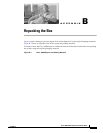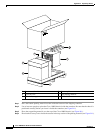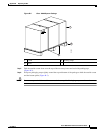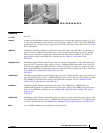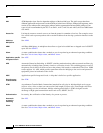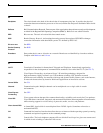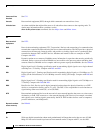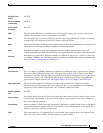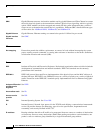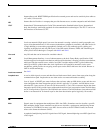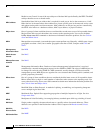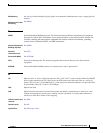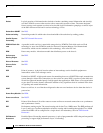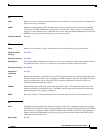
Glossary
GL-4
Cisco 10008 Router Hardware Installation Guide
OL-0659-13
Command Line
Interface
See CLI.
Console
Data terminal equipment (DTE) through which commands are entered into a host.
Critical alarm
An alarm condition that might affect most or all subscribers that connect to the reporting node. To
obtain more information about a problem, use the
show facility-alarm status command. See also Major alarm and Minor alarm.
D
Data terminal
equipment
See DTE.
DCE
Data circuit-terminating equipment (ITU-T expansion). Devices and connections of a communications
network that comprise the network end of the user-to-network interface. The DCE provides a physical
connection to the network, forwards traffic, and provides a clocking signal used to synchronize data
transmission between DCE and DTE devices. Modems and interface cards are examples of DCE.
Compare with DTE.
DRAM
Dynamic random access memory. RAM that stores information in capacitors that must be periodically
refreshed. Delays can occur because DRAMs are inaccessible to the processor when refreshing their
contents. However, DRAMs are less complex and have greater capacity than SRAMs. See also SRAM.
DS0
Digital signal level 0. Framing specification used in transmitting digital signals over a single channel
at 64 kbps on a T1 facility. Compare with DS1 and DS3.
DS1
Digital signal level 1. Framing specification used in transmitting digital signals at 1.544 Mbps on a T1
facility (in the United States) or at 2.108 Mbps on an E1 facility (in Europe). Compare with DS0 and
DS3.
DS3
Digital signal level 3. Framing specification used for transmitting digital signals at 44.736 Mbps on a
T3 facility. Compare with DS0 and DS1.
DSU
Data Service Unit. Device used in digital transmission that adapts the physical interface on a DTE
device to a transmission facility such as T1 or E1. The DSU is also responsible for such functions as
signal timing. Often used with CSU, as in CSU/DSU.
DTE
Data terminal equipment. Device at the user end of a user-network interface that serves as a data source,
destination, or both. DTE connects to a data network through a DCE device (for example, a modem)
and typically uses clocking signals generated by the DCE. DTE includes devices such as computers,
protocol translators, and multiplexers.
Dynamic random
access memory
See DRAM.
E
E1
Wide-area digital transmission scheme used predominantly in Europe that carries data at a rate of 2.048
Mbps. E1 lines can be leased for private use from common carriers. Compare with T1; see also DS1.




